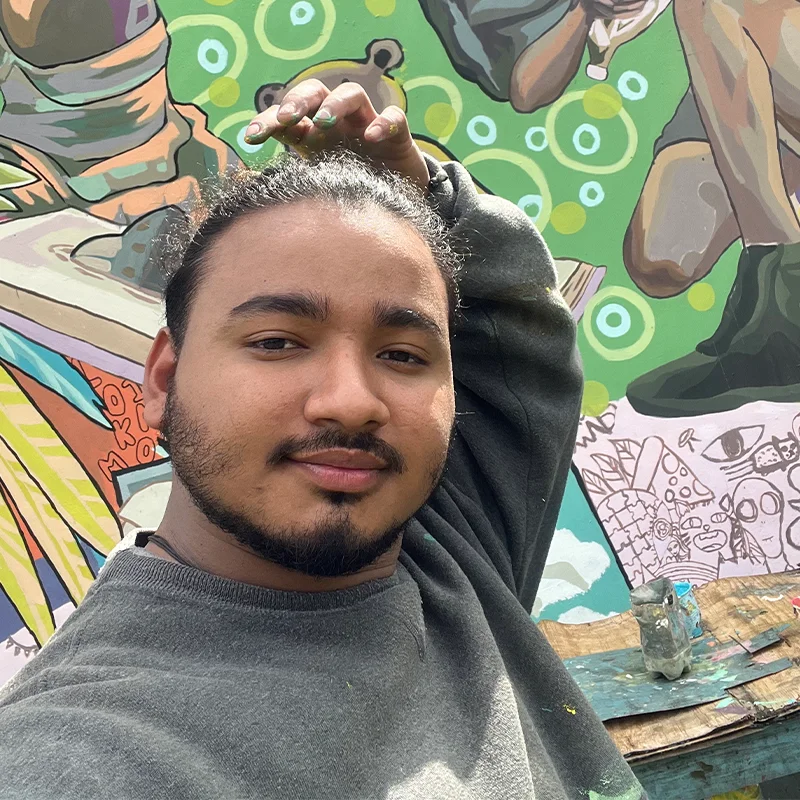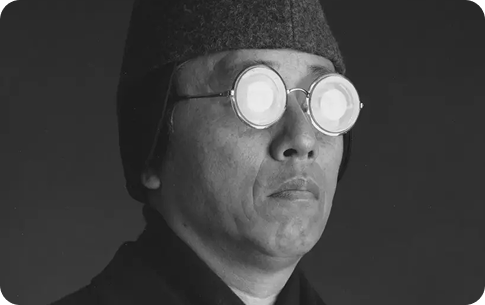
“Some of the kids from my generation in my neighborhood were murdered, others moved away to other parts of the country, or abroad, to the US. And by also leaving my neighborhood I was able to see the need among young people, and for whom it was very difficult to imagine doing something like creating art.”
- Orlin Daniel Canales Martínez
Orlin Daniel Canales Martínez is a 23-year-old Honduran painter, muralist, sculptor, and teacher from the city of El Progreso.
Martínez’s works, in which he involves local youth to create awareness about social issues, tends to portray social realism, politics, and culture. His murals are bold, captivating, and laden with impactful messaging. The creation of each mural begins with a series of workshops where the young participants that he works with discuss the themes to be portrayed, then move on to create drawings that are used in the final work.
The multi-faceted Martínez is also a co-founder of the Giant Kites festival and a sculptor in the Giant Chimneys festival in Santa Bárbara. His dedication to artful impact doesn’t end there, as the young Honduran also works as a teacher within various organizations and cultural foundations across the Central American country, involving children and young people in artistic and cultural projects, particularly in marginalized areas where art often doesn’t reach.
Mostly, Martínez paints murals on walls at schools or colleges. “Sometimes it’s the school itself that hires us to paint a mural, and I usually propose some themes with the young people involved, such as education, violence in the community, migration, sports. The idea is to create a message,” he says.
Honduras is a country in which drug traffickers and violent gangs — such as the MS-13 or Mara Salvatrucha — operate, and Orlin’s murals aim to highlight the problems the local society faces, including an emphasis on the need to achieve the UN’s Global Goals for Quality Education, Gender Equality, Reducing Inequality, and striving for Peace, Justice and Strong Institutions.
“There was a lot of violence and drugs in my neighborhood, and gangs that were fighting over control of the territory,” he tells Global Citizen. “I was displaced by the gangs that operate in my neighborhood and leaving allowed me to see the needs people have. My art has always aimed to portray reality, for example, [the reality] of the kids that live on the street and sell candies to make a living.”
Martínez is able to produce his murals thanks to the support of NGOs such as Educate, with whom he set up a youth art program called ‘EducArte’ in 2023 that he continues to coordinate. He also leads projects supported by the United Network of Young Peacebuilders (UNOY) and is part of the global campaign ‘Peace Starts Here’ with Peace Direct.
“I like working with young people because young people are searching for an identity, they’re asking: ‘Who am I? Who do I want to be?’ And criminal gangs offer them an identity, a way of dressing, certain hairstyles, tattoos, and that concept of identity that gangs offer is very attractive. I like to capture that idea, with graffiti for example, the idea that painting a wall is rebelliousness and a part of youth. But it must have a message, and I aim for it to have a psychological effect and to adapt that identity on a philosophical level,” he explains.
Many of the young people he works with have no experience in art, so the process also involves teaching. “I use a pop-art style, more focused on the message than the technique,” he says. “And the works tend to be quite naïve.”
As a way of introducing themes to depict in the murals, Martínez brings along clippings of local news stories. “I compile stories, things happening in their community, a woman is murdered, for example, a man goes into a church with a machete and murders the priest. We have normalized violence. We hear a bang and we ask, ‘was that a firework or a gunshot?’ We even joke about it. But there is also domestic violence between couples. We talk about all of that in the workshops, and how we can portray that in the mural. Everyone does a drawing and we compile them. I interpret their ideas and we paint a mural with a message.”
Martínez notes that change begins with oneself and the need to create a more just society among young people. “We are all traumatized, from violence, drugs, bullying, and we need a change and to create a new society,” he says.
Despite his work reflecting the existing violence in the country, where civic space is repressed, and the power struggles among gangs for control of neighborhoods, Martínez says he has not suffered any repercussions due to his work. “So far I’ve not had any problems, perhaps because I’m not blaming anybody or holding anybody responsible, but rather portraying problems in a more generalized way.”
For his spotlight with Global Citizen, Martínez has compiled a video that shares some insight into his work.
HIS WORK

Global Citizen’s Emerging Creatives Program provides a platform for emerging creatives in the Global South that are highlighting the need for open civic space worldwide. Through their art, they call for change, shine a light on social injustices, and advocate for the advancement of the Global Goals.
MEET THE MENTOR
Rakaya Esime Fetuga
POET
South African-born Simphiwe Molefe, uses his photography to show the impacts of energy issues in the country. His collection of images titled, Impilo Iyaqhubeka, translates to mean “life goes on” in isiZulu and looks at how every day members of his community cope with South Africa’s ongoing power crisis.
In 2023, South Africa’s civic space rating was downgraded from “narrowed,” to “obstructed” — the third worst rating a country can have. That’s why Molefe believes creatives like himself have a role to play in highlighting the effects of the failure of basic services such as the power crisis in South Africa.

